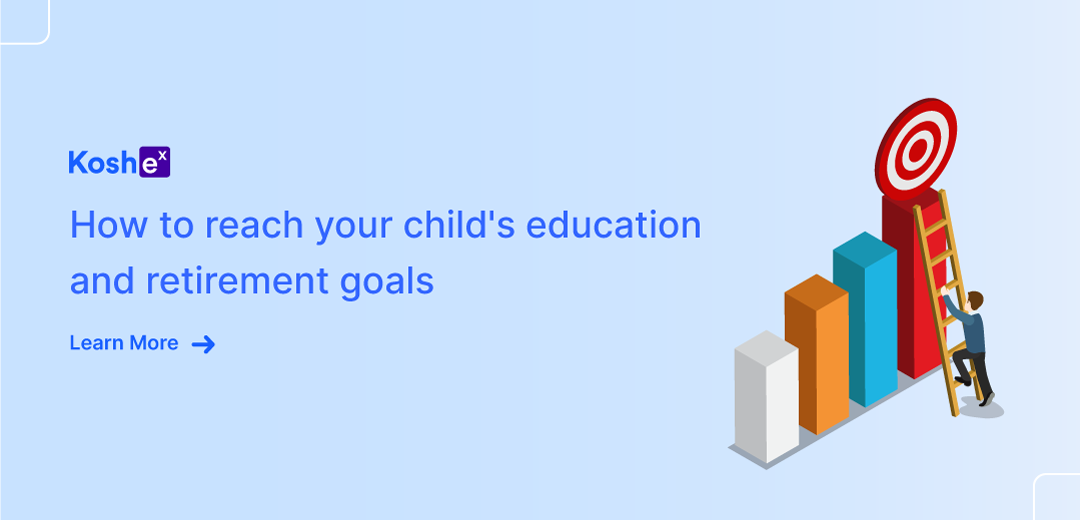In the grand journey of life, few things are as precious as a good education for your child and a secure retirement for yourself. These goals are more than just dreams; they represent years of hard work and security. Achieving them requires smart financial planning.
Imagine giving your child the best education, enabling them to chase their dreams, while also ensuring a comfortable retirement for yourself. It might seem challenging, but it is entirely possible with the right approach.
Balancing your child’s education and your retirement plans isn’t a zero-sum game; it’s a thoughtful strategy that considers your financial resources. And here’s where Koshex, your trusted financial partner, comes in.
With Koshex, you can get hyper-personalized insights and advice tailored to your financial situation. Sign up with Koshex today!
Goal Setting
Setting clear goals is the foundation of your financial journey. It is about having a vision and a well-structured plan.
Defining the Goals
Start by defining your child’s education goals. What type of education do you envision for them? Be specific about the kind of education and its costs.
Simultaneously, outline your retirement goals. What does your retirement look like? Do you dream of traveling, pursuing your passions, or simply enjoying a financially secure life?
Also Read : 3 Best Investment Options for Your Child in India
Prioritization of Goals
Prioritize your goals. Determine immediate ones, like funding primary education, and long-term ones, like preparing for university expenses or retirement. Prioritization helps you allocate your resources effectively.
At the same time, do not forget about your retirement goals. What does retirement look like for you? Do you dream of traveling the world, pursuing a passion, or simply enjoying a peaceful and financially secure life? Clearly defining your retirement goals allows you to work towards them with clarity and purpose.
Setting Realistic Expectations
The secret to successful goal setting is aligning your dreams with your financial capacity. Break down overwhelming goals into manageable steps. Understand how much you need to save and aim high while being realistic.
Similarly, for retirement, understand how much you will need and how much you should save. Koshex can offer personalized insights into financial planning, helping you set achievable milestones for both education and retirement. Sign up today!
Financial Planning for Education
Financial planning for your child’s education is a strategic task that involves various factors. It is about making your money work smartly to fulfill your educational dreams.
Setting up an Education Fund
One effective approach is to set up a dedicated education fund. This fund can be specifically designed to accumulate enough resources to meet your child’s educational needs.
Consider creating a dedicated education fund tailored to your child’s needs. If you have time on your side, opt for more aggressive investments like equity mutual funds. For those closer to college, choose stable, debt-oriented investments to safeguard savings from market volatility.
In India, you can save on taxes when planning for education expenses. Explore deductions under Section 80C of the Income Tax Act, which can ease the financial burden.
Retirement Planning
Retirement planning ensures that you enjoy your golden years without worrying about your finances.
In this section, we will explore effective strategies to build your retirement corpus and the role of retirement accounts, such as EPF (Employee Provident Fund) and PPF (Public Provident Fund).
Timelines and Risk Tolerance
Investment strategies for retirement should be tailored to suit your timeline and risk tolerance. Generally, long-term investments in assets like equities tend to offer higher returns, making them suitable for retirement planning.
Koshex can assist in crafting a well-balanced portfolio that aligns with your retirement goals.
Retirement accounts like EPF can also offer significant advantages. They typically involve contributions from both you and your employer, creating a substantial corpus over time.
PPF is another excellent avenue for building a tax-efficient retirement fund. The interest on PPF deposits is tax-exempt, and the principal amount invested is eligible for tax deductions.
Tax efficiency is a crucial aspect of retirement planning. It is not just about saving money but also about optimizing your returns. Regularly review and adjust your financial plan to adapt to life’s unpredictability. Monitor your investment portfolio to ensure it aligns with your goals.
Also read: Health Care Planning for Retirement
Monitoring and Adjusting
Regularly reviewing and adjusting your financial plan is akin to fine-tuning a well-oiled machine. It ensures that your goals remain within reach and that you’re making the most of your investments.
One aspect of this process is monitoring your investment portfolio. You can analyze how your educational fund and retirement corpus are growing and make informed decisions as needed.
Adaptability is crucial because life is unpredictable. Your child’s educational goals or your retirement timeline might change due to unforeseen circumstances. Remember, your financial journey is a dynamic process. It is not about setting and forgetting.
By utilizing the resources and expertise of Koshex, you can proactively manage your financial goals, whether they are centered on education or retirement.
Key Takeaways
Balancing your child’s education and retirement goals is a journey that demands careful planning and wise financial choices. It is about making your dreams for your child’s education and your retirement a reality.
By setting clear goals, prioritizing wisely, and utilizing tax-efficient investment options, you can confidently work towards these milestones.
Balancing your goals for your child’s future while securing your own retirement is a sensible choice. By setting clear goals, prioritizing wisely, and leveraging tax-efficient investment options, you can achieve these milestones.
Whether you are setting up a dedicated education fund or building your retirement corpus, Koshex’s hyper-personalized insights and seamless transactions can make your financial planning journey more convenient.
Sign up with Koshex today, and let’s work together to secure your child’s education and your dream retirement.
Frequently Asked Questions (FAQs)
Q1. What should I do if my financial situation changes significantly while pursuing these goals?
Ans. In case your financial situation changes significantly, it’s essential to reassess your goals and adjust your financial plan accordingly. You might need to revisit your target savings amounts, timeline, or investment strategies.
Q2. Can I access my retirement funds if there’s an urgent need, such as my child’s education?
Ans. Yes, it is possible to access your retirement funds for specific urgent needs, but it should be done cautiously. Early withdrawals from retirement accounts may incur penalties and taxes. Some retirement plans allow for loans or hardship withdrawals, but these should be considered as a last resort. Explore other options like scholarships, grants, or educational loans before tapping into your retirement savings.
Q3. How can I ensure I am saving enough for my child’s education and retirement?
Ans. To ensure you are saving enough for your financial goals. Having a well-defined plan in place can make all the difference in your financial journey. Consider utilizing financial planning tools, such as the Koshex calculators. These tools can provide you with valuable insights into your savings and investment needs, helping you make informed decisions about your financial future
Q4. Is it okay to take out loans for my child’s education or retirement funding?
Ans. It is essential to use the loans judiciously. Compare loan terms, interest rates, and repayment options carefully. Prioritize low-cost loans, and ensure they fit within your overall financial plan. It is wise to explore other funding sources, like savings and scholarships, before resorting to loans.









Leave a Comment